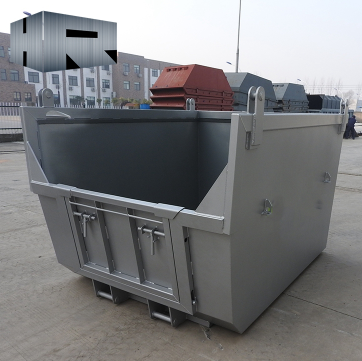
A self-tipping bin, also known as a self-dumping bin or a self-dumping hopper, is a container that has the ability to tilt and empty its contents without the need for manual intervention. These bins are widely used in industrial settings, construction sites, and Waste Management facilities due to their convenience and efficiency.
The mechanism behind a self-tipping bin is quite simple yet effective. The bin is designed with a pivot point and a tipping lip, which allows the contents to be discharged by tilting the bin. Typically, the bin is loaded with materials using a forklift or other lifting equipment. Once the bin is full, it can be easily transported to the desired location for unloading. When it is time to empty the bin, the operator activates a lever or a hydraulic system, causing the bin to tilt forward. As a result, the contents slide out smoothly, and the bin returns to its upright position for the next use.
There are several reasons why self-tipping bins are considered convenient and beneficial in various industries. Let us dive into the advantages of using these bins:
1. Time and labor-saving: Self-tipping bins eliminate the need for manual handling, reducing the labor required for unloading materials. This automation saves time and allows workers to focus on other important tasks, thereby increasing overall productivity.
2. Enhanced safety: Manual handling of heavy materials can be risky, potentially leading to injuries or accidents. Self-tipping bins minimize this risk by eliminating the need for physical exertion. Workers can operate the bins from a safe distance, reducing the likelihood of injuries and improving workplace safety.
3. Increased efficiency: With the ability to empty its contents quickly, a self-tipping bin ensures a seamless flow of materials. This efficiency can significantly improve the overall workflow, especially in industries where a large volume of materials needs to be handled and processed.
4. Versatility: Self-tipping bins come in a range of sizes and designs, catering to various industry needs. They can be used for transporting and unloading different types of materials like construction debris, waste, recyclable materials, agricultural produce, sand, gravel, and more. This versatility makes them valuable across a wide range of applications.
5. Space-saving: In areas where space is limited, self-tipping bins prove to be extremely useful. These bins can be stacked, thereby reducing storage space requirements. Empty bins can be nested inside each other, saving valuable floor space when not in use.
6. Cost-effective: Although self-tipping bins may require an initial investment, their long-term cost-effectiveness outweighs the initial expense. These bins are durable and built to withstand harsh environments, reducing the need for frequent replacements. Additionally, the labor and time savings provided by self-tipping bins can translate into significant cost savings for businesses in the long run.
7. Environmental benefits: Self-tipping bins aid in efficient waste management, allowing for proper disposal and recycling of materials. This contributes to a cleaner and more sustainable environment. By encouraging proper waste management practices, these bins help reduce pollution and promote a greener future.
In conclusion, self-tipping bins offer a convenient and efficient solution for material transportation and disposal. Their time-saving, labor-saving, and cost-effective nature make them highly beneficial in various industries. By optimizing workflow, ensuring safety, and promoting sustainability, self-tipping bins are an essential tool for businesses that deal with large volumes of materials.




Komen
(0)